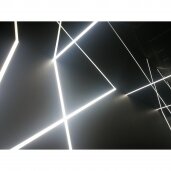
LED Technology:
Energy Saving: LED bulbs use up to 80% less electricity compared to traditional incandescent bulbs. They generate more light while consuming less power, making them particularly popular in both commercial and industrial lighting.
Durability: LED bulbs last longer (up to 50,000 hours), which not only reduces the frequency of replacement but also saves energy in the long term.
Smart Lighting Systems:
Automation: Using motion sensors and smart systems, lighting solutions can automatically adjust the light intensity based on room occupancy or the amount of natural light. This allows energy savings by using lighting only when needed.
Remote Control: Smart lighting systems enable remote control via apps, allowing optimization of energy usage from anywhere.
Energy Efficiency Standards:
Class A Devices: Most modern lighting solutions, such as LED and fluorescent fixtures, have high energy efficiency ratings (A, A+). This means they use minimal electricity while providing sufficient lighting.
Utilization of Natural Light:
Daylight Sensors: Some modern lighting solutions use sensors that measure the level of natural light and automatically adjust artificial lighting to avoid wasting energy during the day.
Types of Lighting Systems and Their Energy Consumption:
Incandescent Bulbs:
Consume a lot of electricity (most energy is lost as heat rather than light).
Efficiency: Very low, recommended to replace with more modern technologies like LED.
Fluorescent Bulbs:
Use less energy than incandescent bulbs but more than LEDs.
Suitable for offices, commercial spaces, where long-term lighting is needed.
LED Bulbs:
Are the benchmark for energy efficiency. They are used everywhere—from homes to industrial spaces due to their low energy consumption and long lifespan.
How to Use Electricity Efficiently for Lighting:
Replace old incandescent bulbs with LEDs – this is one of the simplest ways to reduce electricity costs.
Use smart lighting systems with sensors and timers that turn off lights when not needed.
Take advantage of natural light sources—large windows, skylights can reduce the need for artificial lighting during the day.
Efficient lighting use can significantly reduce electricity costs, contribute to environmental protection, and ensure optimal lighting levels in indoor spaces.












